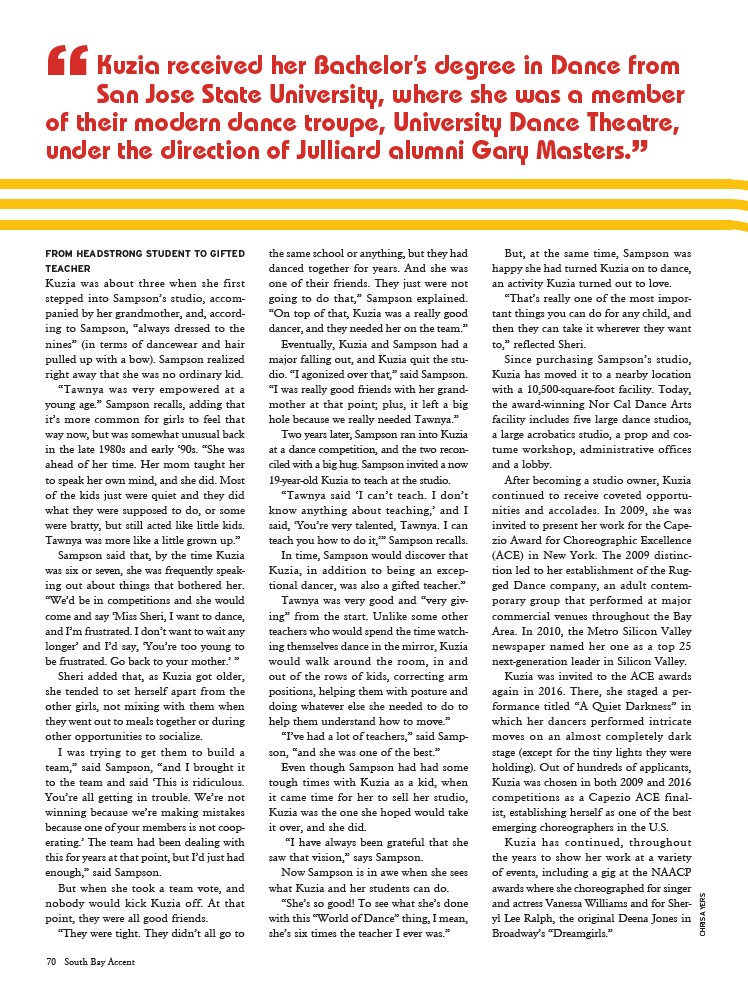
“Kuzia received her Bachelor’s degree in Dance from
San Jose State University, where she was a member
of their modern dance troupe, University Dance Theatre,
under the direction of Julliard alumni Gary Masters.”
FROM HEADSTRONG STUDENT TO GIFTED
TEACHER
Kuzia was about three when she first
stepped into Sampson’s studio, accompanied
by her grandmother, and, according
to Sampson, “always dressed to the
nines” (in terms of dancewear and hair
pulled up with a bow). Sampson realized
right away that she was no ordinary kid.
“Tawnya was very empowered at a
young age.” Sampson recalls, adding that
it’s more common for girls to feel that
way now, but was somewhat unusual back
in the late 1980s and early ‘90s. “She was
ahead of her time. Her mom taught her
to speak her own mind, and she did. Most
of the kids just were quiet and they did
what they were supposed to do, or some
were bratty, but still acted like little kids.
Tawnya was more like a little grown up.”
Sampson said that, by the time Kuzia
was six or seven, she was frequently speaking
out about things that bothered her.
“We’d be in competitions and she would
come and say ‘Miss Sheri, I want to dance,
and I’m frustrated. I don’t want to wait any
longer’ and I’d say, ‘You’re too young to
be frustrated. Go back to your mother.’ ”
Sheri added that, as Kuzia got older,
she tended to set herself apart from the
other girls, not mixing with them when
they went out to meals together or during
other opportunities to socialize.
I was trying to get them to build a
team,” said Sampson, “and I brought it
to the team and said ‘This is ridiculous.
You’re all getting in trouble. We’re not
winning because we’re making mistakes
because one of your members is not cooperating.’
The team had been dealing with
this for years at that point, but I’d just had
enough,” said Sampson.
But when she took a team vote, and
nobody would kick Kuzia off. At that
point, they were all good friends.
“They were tight. They didn’t all go to
the same school or anything, but they had
danced together for years. And she was
one of their friends. They just were not
going to do that,” Sampson explained.
“On top of that, Kuzia was a really good
dancer, and they needed her on the team.”
Eventually, Kuzia and Sampson had a
major falling out, and Kuzia quit the studio.
“I agonized over that,” said Sampson.
“I was really good friends with her grandmother
at that point; plus, it left a big
hole because we really needed Tawnya.”
Two years later, Sampson ran into Kuzia
at a dance competition, and the two reconciled
with a big hug. Sampson invited a now
19-year-old Kuzia to teach at the studio.
“Tawnya said ‘I can’t teach. I don’t
know anything about teaching,’ and I
said, ‘You’re very talented, Tawnya. I can
teach you how to do it,’” Sampson recalls.
In time, Sampson would discover that
Kuzia, in addition to being an exceptional
dancer, was also a gifted teacher.”
Tawnya was very good and “very giving”
from the start. Unlike some other
teachers who would spend the time watching
themselves dance in the mirror, Kuzia
would walk around the room, in and
out of the rows of kids, correcting arm
positions, helping them with posture and
doing whatever else she needed to do to
help them understand how to move.”
“I’ve had a lot of teachers,” said Sampson,
“and she was one of the best.”
Even though Sampson had had some
tough times with Kuzia as a kid, when
it came time for her to sell her studio,
Kuzia was the one she hoped would take
it over, and she did.
“I have always been grateful that she
saw that vision,” says Sampson.
Now Sampson is in awe when she sees
what Kuzia and her students can do.
“She’s so good! To see what she’s done
with this “World of Dance” thing, I mean,
she’s six times the teacher I ever was.”
But, at the same time, Sampson was
happy she had turned Kuzia on to dance,
an activity Kuzia turned out to love.
“That’s really one of the most important
things you can do for any child, and
then they can take it wherever they want
to,” reflected Sheri.
Since purchasing Sampson’s studio,
Kuzia has moved it to a nearby location
with a 10,500-square-foot facility. Today,
the award-winning Nor Cal Dance Arts
facility includes five large dance studios,
a large acrobatics studio, a prop and costume
workshop, administrative offices
and a lobby.
After becoming a studio owner, Kuzia
continued to receive coveted opportunities
and accolades. In 2009, she was
invited to present her work for the Capezio
Award for Choreographic Excellence
(ACE) in New York. The 2009 distinction
led to her establishment of the Rugged
Dance company, an adult contemporary
group that performed at major
commercial venues throughout the Bay
Area. In 2010, the Metro Silicon Valley
newspaper named her one as a top 25
next-generation leader in Silicon Valley.
Kuzia was invited to the ACE awards
again in 2016. There, she staged a performance
titled “A Quiet Darkness” in
which her dancers performed intricate
moves on an almost completely dark
stage (except for the tiny lights they were
holding). Out of hundreds of applicants,
Kuzia was chosen in both 2009 and 2016
competitions as a Capezio ACE finalist,
establishing herself as one of the best
emerging choreographers in the U.S.
Kuzia has continued, throughout
the years to show her work at a variety
of events, including a gig at the NAACP
awards where she choreographed for singer
and actress Vanessa Williams and for Sheryl
Lee Ralph, the original Deena Jones in
Broadway’s “Dreamgirls.”
70 South Bay Accent
CHRIS AYERS